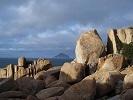Mineralogy is the study of the chemistry crystal structure and physical properties of minerals. The study of the crystal structure leads to the processes of mineral origin and formation, the classification of minerals, the geographical location and there uses.
Physical mineralogy studies the physical characteristics of minerals. These are used to identify the minerals. These characteristics are as follows: crystal structure, crystal habit, twinning, cleavage, luster, diaphaneity, color, streak, hardness and specific gravity. The chemical composition of the minerals will determine their physical characteristics.
Optical mineralogy is the study of minerals that requires a source of light as a means to identify and classify minerals. Not all minerals will refract light. Light is refracted by passing through broken up planes in the minerals that polarize the light to travel at different velocities. The light can be refracted from different angles.
Additionally, minerals have many practical applications which can benefit society. Minerals can be used in building materials, machinery and commodities. As well, minerals can be used for agricultural practices such as in fertilizers.
Title Image Credit: flickr.com
© BrainMass Inc. brainmass.com June 30, 2024, 9:25 am ad1c9bdddf
